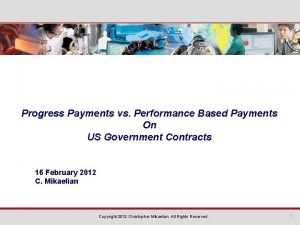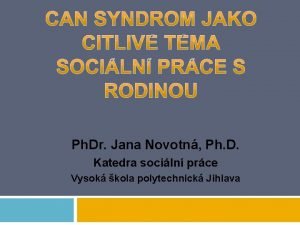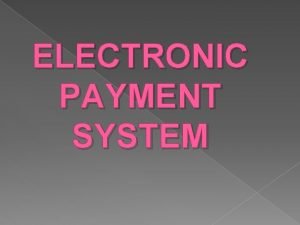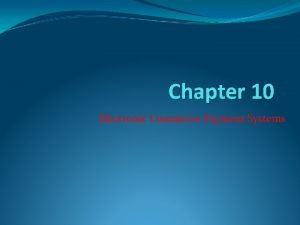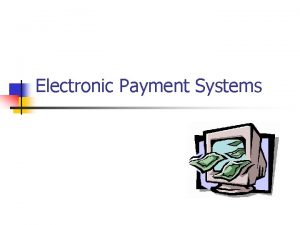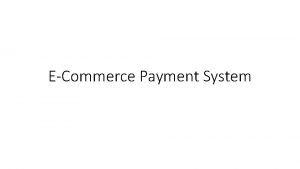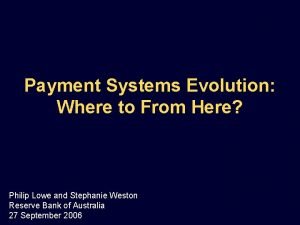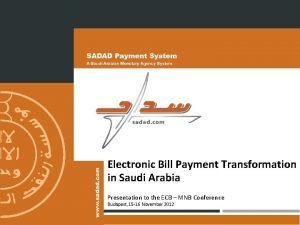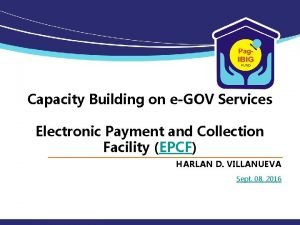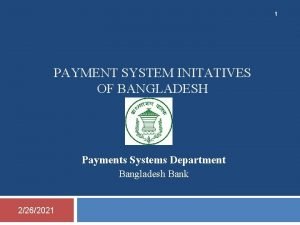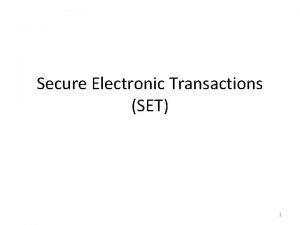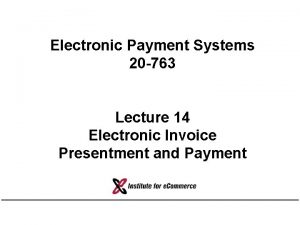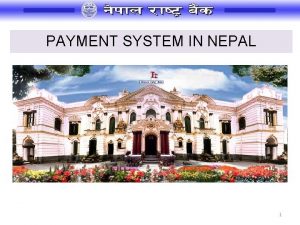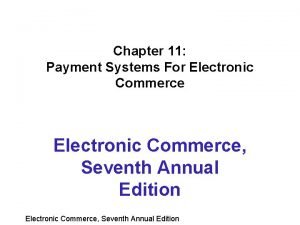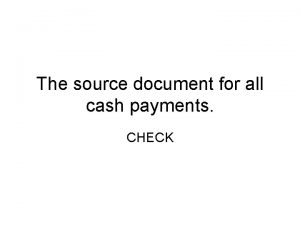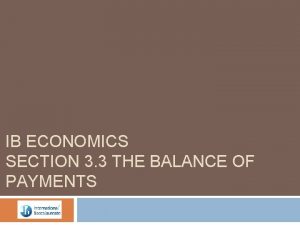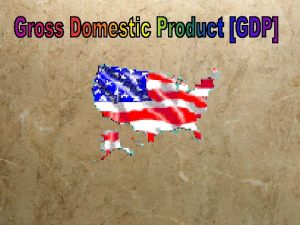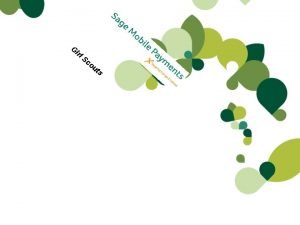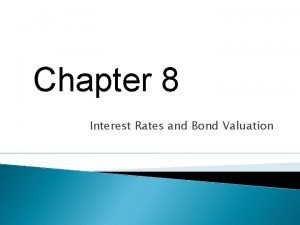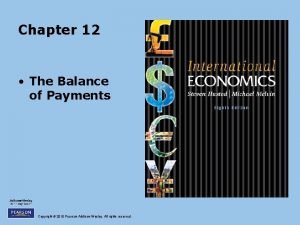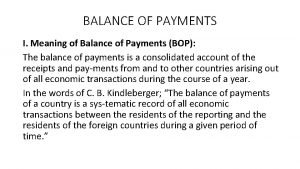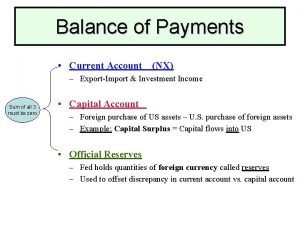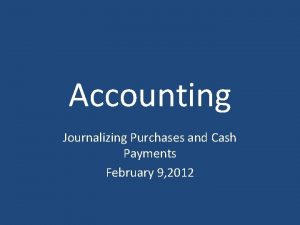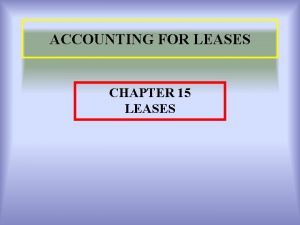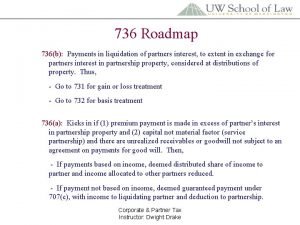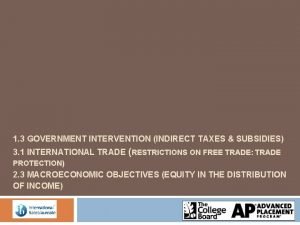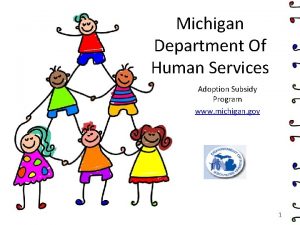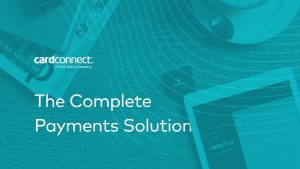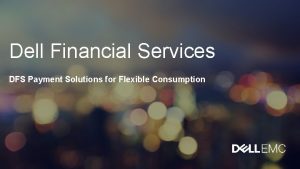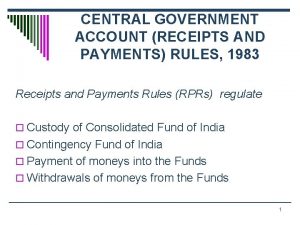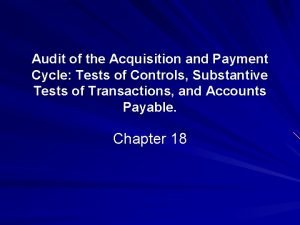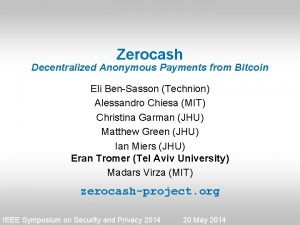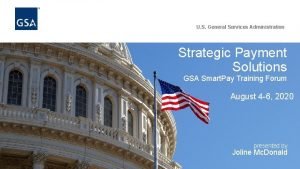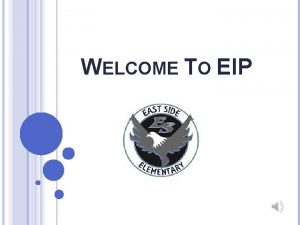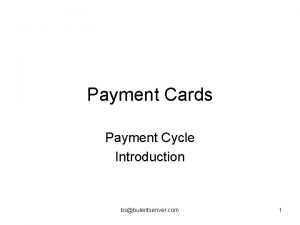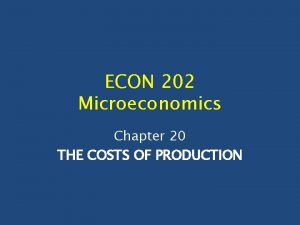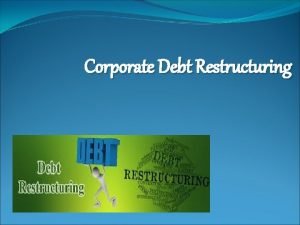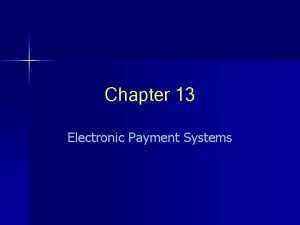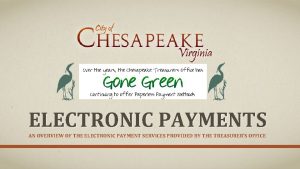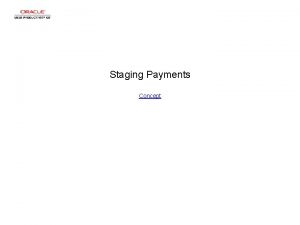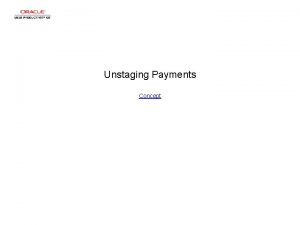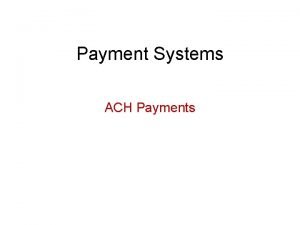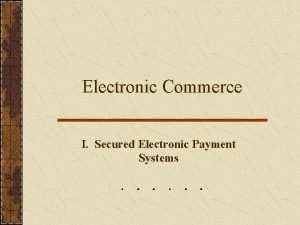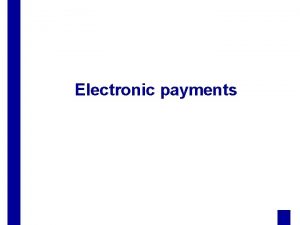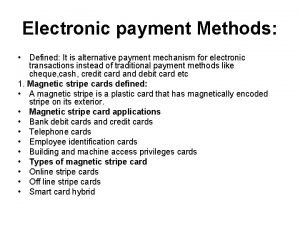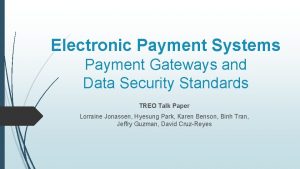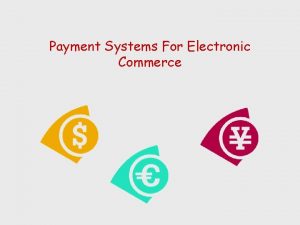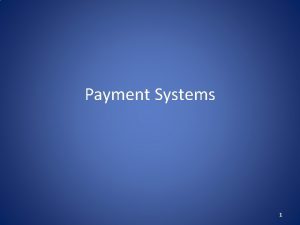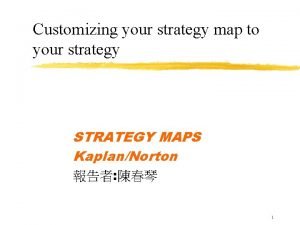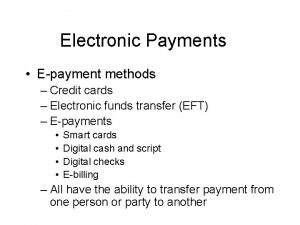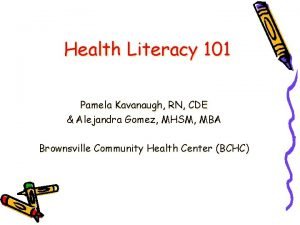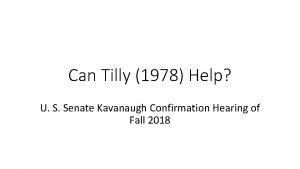Electronic Payments Whats your Payment Strategy Mike Kavanaugh
















































- Slides: 48

Electronic Payments: What’s your Payment Strategy? Mike Kavanaugh Payment Products Consultant Bank of America Merrill Lynch July, 2016 Rick Brown Sr. Client Manager Bank of America Merrill Lynch

Agenda 1 Electronic Payment Growth Trends 2 Cost of a Paper Check 3 Building a Comprehensive Payables Strategy 4 Electronic Payment Alternatives 5 2 Mobile Payments

Electronic Payment Trends

Automation trends Paper to electronic payment conversion continues 27% One in four companies has made a significant investment in automation Transaction Growth by Payment Type Electronic payment methods increase as check payment continues to decline: Automation provides many value adds to a buying organization: ü Reduce overall payment costs ü Remove paper from A/P department ü Better cash management ü Reduce risk of payment fraud ü Reduce instances of duplicate payments ü Access to benefits of new technologies ü Reduction of invoice payment errors ü Ensure compliance with regulations ü Improved visibility into spend 4 Source: 2011 Paystream Advisors. Source: Federal Reserve and NACHA research

Current Payment Mix * Overall B 2 B check payments have decreased year over year 5

Cost of a Paper Check

The Cost of a Paper Check Identify Costs – Key components It’s easy to limit cost considerations to the physical materials used to print and mail checks at the front-end of the process but that may only scratches the surface. In truth costs exist at every step from initiation through reconciliation across seven key components. v. Labor – Initiation – purchasing, safeguarding, maintaining supplies; printing, signing, packaging, and mailing checks. Reconciliation – reconciliation and research of paid and outstanding payments, along with escheatment, may be some of the largest components of cost for paper checks whether in-house or outside services. v. Materials – check stock remittance paper stock, envelopes, and postage v. Fraud Control – protections are robust and absolutely needed to help thwart check fraud v. Equipment/Systems Integration – check printer and space to house it and check stock, systems to support reconciliation data delivery, receipt, and A/P integration. v. Cash Management – uncertainty of check clearing timing can wreak havoc on cash forecasting needs for making daily investment/borrowing decisions. v. Bank Fees – in addition to check fraud protection and controlled disbursement services, banks provide check outsourcing and account reconciliation solutions to automate and streamline many of the labor-intensive elements of the check creation and reconciliation processes. 7

Cost of Checks 8 8

Industry Estimates and Resources Ø Per check cost calculations are dependent upon a large number of factors and influenced by the volume of payments and the automation of the organization. Ø Published study shows the median cost to pay an invoice is $6. 24, with an average of $11. 63*. Anecdotal estimates shared by clients have ranged as high as $25 per payment. Ø Bank of America typically references a conservative estimate of $4 per check when discussing the potential benefit of electronic payments. § Numerous benchmarking studies, such as the following resources, can further illuminate the elements involved in calculating your costs and the industry average costs per check. § The Institute of Finance and Management AP Department Benchmarks and Analysis (2010 study) § Aberdeen Group’s Global Payments: Maximizing Cash flow with Electronic Payments and Process Automation (published 2010) § The Phoenix-Hecht Blue Book of Bank Prices (2013 -2014 issue) 9 * The Institute of Finance and Management AP Department Benchmarks and Analysis (2010 study)

Q. Which payment method is your most expensive? 10 10

Building a Comprehensive Payment Strategy

Get Ready - Take Action Now: v. Develop a well-defined payment strategy with multiple payment options v. Evaluate the different payment type characteristics and perform a cost/benefit analysis when determining what method is chosen for which payment types v. Focus on streamlining Procure-to-Pay process through various electronic automation tools. v. AP and Procurement must be strategically aligned with business needs v. Recognize the efficiencies of electronic payments: v Card integration is more efficient than check payment because process steps, such as invoice receipt and processing, manual reconciliation, and check printing and mailing can be eliminated 12 How do you define “best-in-class”? QUICKEST PAYMENT TRANSACTION TURNAROUND TIME LOWEST ACCOUNTS PAYABLE PROCESSING COSTS HIGHEST DEGREE OF AUTOMATION IN THE PROCURE-TO-PAY PROCESS Source: “Top Guidelines for Successfully Leveraging Supplier E-Invoicing Networks. ” Gartner Research June 2010)

Take Action Now: 13

Keep in mind: Checks and Wires Are Costly 14

Reduce Checks and Wires v. Create deterrents for check payments v v v 15 Charge for a check Longer payment terms Print Checks less often 15

Electronic Payment Alternatives

Electronic Payment Options Ø Purchasing Card/Travel Card – use card technology for small dollar purchases or T&E to streamline processes. Department cards and CTA/BTA accounts for travel agencies are common. Ø Virtual Payables – use card technology for to send secure invoice payments electronically. Ghost cards and virtual payables provide secure cardless options for electronic payments. Ø Automated Clearing House (ACH) Services – An electronic payment delivery system that allows you to pay electronically through the ACH network. The speed, accuracy, and efficiency of electronic ACH payments gives you better control over timing of payments posting to your bank accounts. Ø Wire Transfer – in almost every currency, wire transfer assures finality of payment, provides immediate availability of funds and provides global payment capabilities. Ø Electronic Invoice/Bill. Pay – end-to-end workflow streamlines a paperless payables process from invoice management to payment reconciliation. Ø Prepaid Card – make fast, easy and more secure payments to consumers. Cards are reloadable for recurring payments, and offer a convenient payment solution for those customers who may not have a checking account, or card not to share bank information. Ø Digital Disbursements – economical and convenient way to distribute funds to U. S. consumer customers using just heir mobile number or email address, regardless of which U. S. based financial institution they use. 17

Implement Electronic Payments - Purchasing Cards Goal: Optimize your card programs 18

Past P-Card Spending Growth © 2014, R. Palmer and M. Gupta 19

North American P-Card Spending by Category of Purchase (in $ billions) © 2014, R. Palmer and M. Gupta 20

Future Growth Overall growth = 10. 8% per year Corporate growth =12. 4% per year Government and Not-for-Profit = 8. 8% per year © 2014, R. Palmer and M. Gupta 21

Future P-Card Growth in $ © 2014, R. Palmer and M. Gupta 22

P-card Growth by Segment in $ Corporations Government and Not-for-Profit © 2014, R. Palmer and M. Gupta 23

Future Growth – Are You Ready? Expecting growth in traditional account spending? Expecting growth in EAP spending? © 2014, R. Palmer and M. Gupta 24

Low cost payment processing REDUCE $90 $20 77% decrease *Source: 2014 Purchasing card Benchmark Survey results, RPMG Research Corporation 25 processing cost Research has indicated that moving to card payments reduces the average processing cost of a single requisition from $90. 20 to $20. 38*. Other benefits: Automation of the payment process. Minimizes human intervention in the process, leading to reduced FTE time and cost. Automation of the expense reporting and reconciliation process.

Speed up payment processing SIMPLIFY processes Research has indicated that moving to card payments reduces the average processing time from 11. 4 days to 3. 4 days*. 26 Steps 8 Steps 70% faster *Source: 2014 Purchasing card Benchmark Survey results, RPMG Research Corporation 26 Other benefits: Reduces paper and manual involvement in the expense, reconciliation and reporting processes. Less time spent reconciling receipts and expenses. Greater convenience for cardholders through optimized transaction reporting processes.

Card payments, the value addition available As compared to paper payments, card payments offer the following benefits: Increased Days Payable Outstanding Up to 55 days Lower processing costs 77% decrease Faster execution 27 70% faster

Best practices: Purchasing Card v. Assess purchasing card program potential by analyzing check payments and reviewing purchase requisition traffic v. Target specific vendors, commodities or services for card payments v. Mandate use of purchasing cards for transactions that are below a specific dollar amount v. Maximize spend to generate optimal financial benefit and data capture v. Add travel cards, declining balance cards and pre-approval process workflow to cards 28 v. Regularly communicate purchasing card info to cardholders and managers v. Attend purchasing card user conferences v. Distribute cards to a higher % of employees, have higher spending limits, and adopt policies to drive low-value spending to the cards v. Offer easy online access to frequently asked questions; promote program v. Expand program to additional employees and expense types v. Credit limit refresh control

Implement Electronic Accounts Payable – Virtual Card v. Referred to as Ghost Card – no plastic, AKA epayables and SUA v. A form of automated electronic payment, using the card on the back end after matching PO and Invoice entry & approval v. Can be one card per vendor or one card per invoice payment v. Can send detailed remittance information to suppliers v. Total automation with “card run” versus check run 29

Electronic Accounts Payable – Virtual Card 30

Electronic Accounts Payable – Virtual Card 31

Best practices: Electronic Accounts Payable - Virtual Card v. Offer Vendors faster payment terms for accepting an electronic payment (20 day / 45 day / 60 day) v. Make vendor enrollment an ongoing process. Compile and submit to your Bank an updated vendor file (A/P file) every 6 to 12 months for a match and campaign/vendor outreach. v Incorporate payments via credit card as a standard payment option in all supplier agreements. v Include payments via credit card as a standard payment option in all Request for Proposals 32

Expanding your success EXPAND MONITOR EVALUATE DRIVE After initial supplier campaign efforts are finished, leverage program tools and technology to further drive supplier adoption of card. 33 Evaluate supplier base on a regular basis. Execute follow-up marketing efforts as needed – either via formal calling campaigns or self managed supplier enrollment. Monitor payment activity to ensure supplier adoption and ongoing adherence to the card program. Ensure card is presented as the preferred payment type for new suppliers. Performance measurements/metrics, adoption, cash discounts and saved. Expand paper-toelectronic migration to other payables transactions. Review existing supplier payment arrangements to optimize card acceptance and electronic payment conversion.

Standard ACH Model Option 34

Implement Electronic Accounts Payable – Paymode-X Connect ACH Payments v Electronic payments to non-card accepting suppliers v Fully automated using the same or separate payment file as virtual card v Paymode-X supplier network = 330, 000+ v Suppliers paid the next day v Can send unlimited remittance information to suppliers in their custom format or post detail in Paymode-X portal v Send reimbursement payments to employees v Eliminate supplier bank account risk exposure Earn cash rebates on supplier ACH payments 35 35

Best practices: Paymode-X Connect ACH v. Mandate Paymode-X ACH payments for non-card accepting vendors v. Offer Vendors faster payment terms for accepting an Paymode-X ACH payment vs check. v. Look at cutting checks once a month or every three weeks to encourage Paymode-X ACH payments v. Make vendor enrollment an ongoing process 36

Simplifying payments to your suppliers Paymode-X Connect Buyer receives a quarterly dividend on eligible Premium suppliers spend Buyer Paymode-X processing Debit/Credit any bank Payments processed to suppliers* Premium suppliers only Remittance delivery Single payment file Any ERP Any AP host software output buyer payment initiation Small % fee assessed on dollars processed payment and data processing by Paymode-x supplier receives payment with remittance details Web reports, EDI/CTX, customized AR file and/or via email delivery buyer receives quarterly dividend on eligible spend *This workflow illustrates Premium membership – the prioritized membership during supplier enrollment campaign Basic membership is available – suppliers do not pay a fee to accept the payment, but have access to fewer tools and service benefits. For example, remittance information for Basic members is available through web reports only. 37

Other Electronic Payment Alternatives

Pre. Paid Card v Objectives and challenges v Disbursing payments v Facing a difficult, time-consuming reconciliation process v Reducing costs v Check processing costs v Bank fee, reconciliation and escheatment costs v Financial liability costs v Reducing risk exposure v Security of cash on hand v Check fraud exposure v Streamlining administration v Manual payment processes v Duplicative efforts v Check replacement costs v Cash management 39 39

Pre. Paid Cards Disbursement Types Retirement/ pension Unemployment/ disability Payments/ reimbursements Incentives/ rewards TANF Other benefits Government Payroll Tax refunds Worker’s compensation 40 Child support

Benefits to government Reduced costs ▪ ▪ Reduced risk ▪ Mitigates the liability/cost associated with cash or lost or stolen checks Streamlined administration ▪ 41 Successfully helps integrate electronic payments, while improving staff productivity Eliminates check processing and recurring postage costs Reduces bank fee and account reconciliation costs Better efficiency ▪ Government Quicker and more successful reconciliation of funds than through paper-based, manual methods Improved transparency ▪ Easier to monitor disbursements to show effective management and accountability

Benefits of recipients Disbursement My Benefits No Checks! Money goes right to the card – no waiting in line and no check cashing fees Convenient Use the card at a store or online Cash Access Buy things and get cash back, or go to an ATM or bank Security If the card is stolen or lost, get a new card and not be held liable for fraudulent charges (subject to certain terms and conditions) Customer Service 24/7 help via internet or toll-free number 42

Mobile Payments

Mobile Payments Rethink your payment process reduce variable disbursement expenses by nearly 50% Distribute funds without paper helps minimize escheatment management To any financial institution Using mobile number or email address 44 recipients receive payments more quickly eliminate the need to obtain sensitive bank account information

The Move to Mobile Life has changed 1990 s v. In 2013, 95 million U. S. adults used mobile banking – a gain of 27 million mobile bankers over 2012. (1) v. By 2018, 63% of the mobile consumer population is forecasted to be using mobile banking (2) v. With 200% growth (42 M new consumers in 2013), tablet adoption is outpacing smart phone adoption (36 M new in 2013)—showing consumers are adopting new technologies faster than ever. (1) v. Nearly as many mobile devices as people in the world by 2015 (2) 2010 s Source: (1): Javelin Strategy & Research, MOBILE BANKING, TABLET AND SMARTPHONE FORECAST 2013 -2018: Smart Device Adoption Drives Mobile Banking Boom, March 2014 (2): Javelin Strategy & Research, Mobile Payments to hit $20 Billion in 2012 45

Customer payment solution: Mobile Payments 1 Business 2 METHOD CONFIRMATION Confirm recipient agrees to receive a digital disbursement. Account information is not shared among participants 46 Business 3 PAYMENT INITIATION Send us your recipient’s email address or mobile number and the payment amount. Registration occurs at in-network banks or clear. Xchange. com Recipient PAYMENT NOTIFICATION The recipient receives an email or text with instructions for receiving the money. Unregistered Recipient 4 ONE-TIME REGISTRATION 5 The recipient registers an email address or mobile number one time. FUNDING RECEIVED Payment is automatically deposited into the recipient’s account the same or next day. * Email or text notifications, online or mobile banking applications Near real-time messaging and faster payment to recipient Money movement and fraud screens performed by bank Recipient Credit Push model Business receives optional reporting, including Current day/Previous Day IR notifications * Please note: time references when payments are generally available. Operating rules specify within 3 days

Electronic Payments: What’s Your Strategy? Questions? 47

Notice to Recipient "Bank of America Merrill Lynch" is the marketing name for the global banking and global markets businesses of Bank of America Corporation. Lending, derivatives and other commercial banking activities are performed globally by banking affiliates of Bank of America Corporation, including Bank of America, N. A. , member FDIC. Securities, strategic advisory, and other investment banking activities are performed globally by investment banking affiliates of Bank of America Corporation ("Investment Banking Affiliates"), including, in the United States, Merrill Lynch, Pierce, Fenner & Smith Incorporated and Merrill Lynch Professional Clearing Corp. , both of which are registered as broker-dealers and members of SIPC, and, in other jurisdictions, by locally registered entities. Merrill Lynch, Pierce, Fenner & Smith Incorporated and Merrill Lynch Professional Clearing Corp. are registered as futures commission merchants with the CFTC and are members of the NFA. Investment products offered by Investment Banking Affiliates: Are Not FDIC Insured * May Lose Value * Are Not Bank Guaranteed. This document is intended for information purposes only and does not constitute a binding commitment to enter into any type of transaction or business relationship as a consequence of any information contained herein. These materials have been prepared by one or more subsidiaries of Bank of America Corporation solely for the client or potential client to whom such materials are directly addressed and delivered (the “Company”) in connection with an actual or potential business relationship and may not be used or relied upon for any purpose other than as specifically contemplated by a written agreement with us. We assume no obligation to update or otherwise revise these materials, which speak as of the date of this presentation (or another date, if so noted) and are subject to change without notice. Under no circumstances may a copy of this presentation be shown, copied, transmitted or otherwise given to any person other than your authorized representatives. Products and services that may be referenced in the accompanying materials may be provided through one or more affiliates of Bank of America, N. A. We are required to obtain, verify and record certain information that identifies our clients, which information includes the name and address of the client and other information that will allow us to identify the client in accordance with the USA Patriot Act (Title III of Pub. L. 107 -56, as amended (signed into law October 26, 2001)) and such other laws, rules and regulations. We do not provide legal, compliance, tax or accounting advice. Accordingly, any statements contained herein as to tax matters were neither written nor intended by us to be used and cannot be used by any taxpayer for the purpose of avoiding tax penalties that may be imposed on such taxpayer. For more information, including terms and conditions that apply to the service(s), please contact your Bank of America Merrill Lynch representative. Investment Banking Affiliates are not banks. The securities and financial instruments sold, offered or recommended by Investment Banking Affiliates, including without limitation money market mutual funds, are not bank deposits, are not guaranteed by, and are not otherwise obligations of, any bank, thrift or other subsidiary of Bank of America Corporation (unless explicitly stated otherwise), and are not insured by the Federal Deposit Insurance Corporation (“FDIC”) or any other governmental agency (unless explicitly stated otherwise). This document is intended for information purposes only and does not constitute investment advice or a recommendation or an offer or solicitation, and is not the basis for any contract to purchase or sell any security or other instrument, or for Investment Banking Affiliates or banking affiliates to enter into or arrange any type of transaction as a consequent of any information contained herein. With respect to investments in money market mutual funds, you should carefully consider a fund’s investment objectives, risks, charges, and expenses before investing. Although money market mutual funds seek to preserve the value of your investment at $1. 00 per share, it is possible to lose money by investing in money market mutual funds. The value of investments and the income derived from them may go down as well as up and you may not get back your original investment. The level of yield may be subject to fluctuation and is not guaranteed. Changes in rates of exchange between currencies may cause the value of investments to decrease or increase. We have adopted policies and guidelines designed to preserve the independence of our research analysts. These policies prohibit employees from offering research coverage, a favorable research rating or a specific price target or offering to change a research rating or price target as consideration for or an inducement to obtain business or other compensation. Copyright 2014 Bank of America Corporation. Bank of America N. A. , Member FDIC, Equal Housing Lender. 48
 Performance based payment
Performance based payment Ostc mistar
Ostc mistar Lakrimace
Lakrimace Eps full form in banking
Eps full form in banking Electronic commerce payments inc
Electronic commerce payments inc Which is the objective of electronic payment system
Which is the objective of electronic payment system Paytrust bill center
Paytrust bill center Digital accumulating balance payment system
Digital accumulating balance payment system Evolution of electronic payment system
Evolution of electronic payment system Benefits of electronic payment system
Benefits of electronic payment system Electronic bill presentation and payment
Electronic bill presentation and payment Electronic payment and collection facility (epcf)
Electronic payment and collection facility (epcf) Beftn meaning
Beftn meaning Secure electronic transactions
Secure electronic transactions Yodelee
Yodelee Nepal electronic payment system
Nepal electronic payment system Payment systems for electronic commerce
Payment systems for electronic commerce Is the electronic exchange of money or scrip
Is the electronic exchange of money or scrip Electronic field production examples
Electronic field production examples Give us your hungry your tired your poor
Give us your hungry your tired your poor Is the source document for all cash payments a check
Is the source document for all cash payments a check Balance of payments include
Balance of payments include Government transfer payments examples
Government transfer payments examples Sage irl
Sage irl Payments 101 training
Payments 101 training Pv of coupon payments
Pv of coupon payments Balance of payments equilibrium
Balance of payments equilibrium Balance of payments equilibrium
Balance of payments equilibrium What is the current account of the balance of payments
What is the current account of the balance of payments Hr connex pension
Hr connex pension Chapter 9 journalizing purchases and cash payments answers
Chapter 9 journalizing purchases and cash payments answers Capital lease 4 criteria
Capital lease 4 criteria An endorsement indicating a new owner of a check
An endorsement indicating a new owner of a check 736b payments
736b payments Producer tax burden
Producer tax burden Ocb payments
Ocb payments Philips ihb payments
Philips ihb payments Adoption subsidy michigan
Adoption subsidy michigan Isv payment program
Isv payment program Dell
Dell Dell financial solutions
Dell financial solutions Receipts and payments rules 1983
Receipts and payments rules 1983 Acquisition and payment cycle
Acquisition and payment cycle Zerocash decentralized anonymous payments from bitcoin
Zerocash decentralized anonymous payments from bitcoin Strategic payment solutions
Strategic payment solutions My payments plus
My payments plus Payments cycle
Payments cycle Explicit costs are payments the firm makes for
Explicit costs are payments the firm makes for Broad areas of corporate restructuring
Broad areas of corporate restructuring
